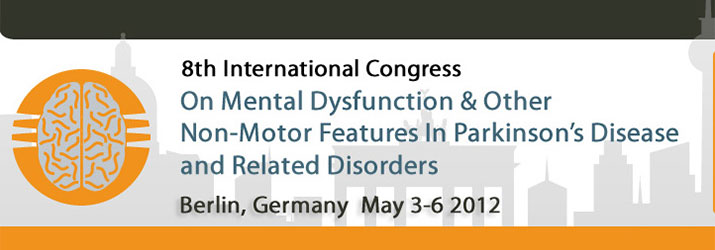

In another plenary session, novel aspects such as the need for a new Non-Motor Staging of Parkinson’s was proposed by Professor Chaudhuri, who suggested a clinical translation of neuropathological findings proposed by K Jellinger. Professor Giladi reviewed the clinical features of asymptomatic mutation carriers in genetic forms of PD. Professor Burn discussed the range of visual impairments experienced by patients. Although some of these symptoms are likely to stem from “central” visual processing deficits, others may be related to lower level disturbances of visual functions.
In a subsequent plenary session, Dr V Voon from Cambridge covered the role of reward and impulsivity in Impulse Control Disorder (ICD), showing important differences between dopamine agonist effect in terms of impulsive choice and compulsive gambling and imaging differences. Professor A Guekht from Russia spoke about the economic burden of non-motor symptoms in PD and Dr. Bergman covered the non-motor neural networks of the basal ganglia and how they respond to emotional stimuli.
In a DBS session Professors P Krack and V Kostic discussed the non motor effects of deep brain stimulation in Parkinson’s and discussions were also held by Dr M Samuel and Professor W Paulus among others.
Another session covered the important sleep symptoms of REM Sleep Behaviour Disorder (RBD) in PD organised by Professors W Oertel and R Postuma. The importance and usefulness of polysomnography (PSG) in the correct diagnosis of RBD was discussed by Dr. Diederich. Minor changes of macro- and microstructure of sleep in the early stages of sleep will be more pronounced in the late stages of PD but common sleep dysfunction syndromes are not more frequent. RBD has the potential to cause serious injury as Dr. Singer mentioned and it can be the first sign of neurodegenerative disorders like synucleinopathies (>50% increased chance for PD). Due to the high risk factor of RBD leading to a neurodegenerative condition and its latency, it creates a window of opportunity for the neuroprotective agents which can be used in clinical trials. Professor Postuma explained early occurrence of dysautonomia in PD patients and its values as a predictor. The role of Diffusion Tensor Imaging (DTI) in detecting microstructural changes of brainstem, substantia nigra, and olfactory regions in idiopathic RBD based on Braak’s 2003 theory of ascending degeneration was discussed. Other important symposia included one led by care of the elderly colleagues and the British Geriatric Society from the UK highlighting non motor issues in Parkinson’s, presided over by Professor R Walker with lectures from Dr P Fletcher, Dr J Hindle and Dr R Genever. The session was widely attended and addressed often neglected topics related to palliative care, cognitive issues and the role of technologies in old age Parkinson’s.
A further symposium was dedicated to the role of therapies and included talks by Anne Martin (PD nurse specialist), Julia Johnson (speech and language therapist who focused on new devices to improve loudness of voice in Parkinson’s). Mariella Graziano, Margarita Makoutonina and F Adib spoke on physiotherapy, the role of occupational therapy and special interst groups in Parkinson’s respectively.
Several other sessions focused on the important issue of cognition, from mild cognitive impairment to dementia and scales for assessment (M Emre, I Rektorova, J Kulisevsky, R Brown, Z Pirtosek), autonomic dysfunctions (A Korczyn, E Hirsch), sleep disorders (C Trenkwalder, C Singer, A Krygowska) and olfaction (R Pfeiffer, T Hummel). Professor A Storch argued that Parkinson’s is a neuropsychiatric disorder, while Professor M Emre focused on mild cognitive impairment and Professor P Barone linked non motor symptoms as a whole with cognitive problems.
There were several poster presentations with prizes for the best 5 posters as well as oral communications from D Berg, A Antonini and M Onofrj among others.
Satellite sessions covered diverse topics such as “Gilles De la Tourette (GDT) is more than tics!” which was put together by Drs Worbe, Cavana and Limousin. Anatomy and pathophysiology of Tourette syndrome (TS) was discussed based on a recent possible animal (monkey) model and the molecular basis of how abnormal movement behaviours were replicated after lesions to different parts of Globus Pallidus (GPi) and Striatum. Dr. Cavana stressed the importance of comorbid disorders, ADHD more than OCD and tics especially for treatment purposes. Only 12% of TS patients have no other recognised abnormality. New treatments for adult patients include partial dopamine agonists like aripiprazole. Dr. Limousin spoke of DBS insertion in severe cases, especially in the GPi when tics cause injury.
In another session, Professor K Bhatia, Dr S Schneider and Dr S Engelender discussed the important clinical molecular genetic aspects of neuronal brain iron accumulation syndromes.
The conference dinner was hosted at the historical “Zollpackhof” and was attended by all faculty. The planned venue for the next “niche” meeting, highlighting non motor aspects of Parkinson’s, will be Seoul in South Korea in April 2013.
In another session, Professor K Bhatia, Dr S Schneider and Dr S Engelender discussed the important clinical molecular genetic aspects of neuronal brain iron accumulation syndromes.
The conference dinner was hosted at the historical “Zollpackhof” and was attended by all faculty. The planned venue for the next “niche” meeting, highlighting non motor aspects of Parkinson’s, will be Seoul in South Korea in April 2013.

